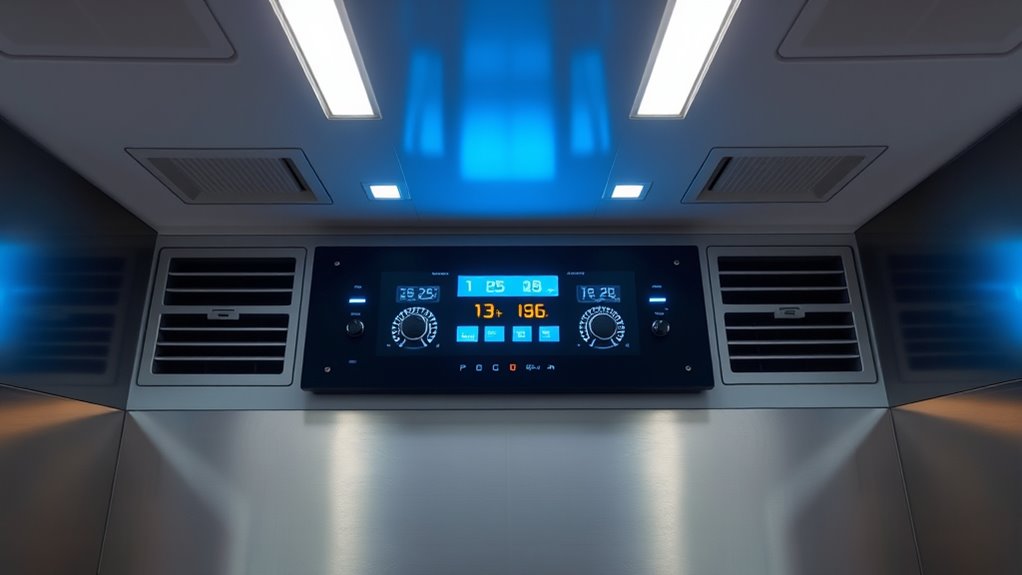To master climate control, you need to effectively manage both temperature and humidity. Use ventilation strategies like cross-ventilation and exhaust fans to circulate fresh air and remove excess moisture. Control humidity levels with dehumidifiers or humidifiers to keep moisture between 30-50%, preventing mold or dryness. Integrating these systems ensures a balanced indoor environment that stays comfortable and healthy, no matter the weather outside. Keep exploring to uncover how these techniques work seamlessly together.
Key Takeaways
- Integrate ventilation and humidity systems to maintain balanced indoor air quality and comfort.
- Use dehumidifiers and humidifiers to keep moisture levels between 30-50%.
- Employ cross-ventilation and exhaust systems for effective temperature and humidity regulation.
- Regularly monitor indoor conditions to adjust climate control devices proactively.
- Prioritize energy-efficient solutions to optimize climate management and reduce operational costs.

Have you ever wondered how some spaces stay perfectly comfortable regardless of outside weather? The secret lies in effective climate control, which involves mastering both temperature and humidity management. When it comes to maintaining an ideal indoor environment, ventilation strategies play a crucial role. Proper ventilation ensures fresh air circulates throughout the space, removing stale air and reducing indoor pollutants. By implementing targeted ventilation strategies, you can prevent stuffiness and maintain a constant flow of air that keeps your environment fresh and comfortable. For example, cross-ventilation—opening windows on opposite sides of a room—can quickly cool down a space on a warm day, while exhaust fans help remove excess humidity and odors. Mechanical ventilation systems, like energy recovery ventilators (ERVs), further improve air quality by exchanging indoor air with fresh outdoor air efficiently, minimizing energy loss.
Humidity regulation is equally important because it directly influences comfort and health. Too much humidity makes a space feel sticky and oppressive, encouraging mold growth and dust mites, which can aggravate allergies. On the other hand, too little humidity causes dry skin, irritated eyes, and respiratory discomfort. To strike the right balance, you need reliable humidity control devices such as humidifiers and dehumidifiers. These devices work together with your ventilation system to maintain ideal moisture levels—usually between 30% and 50%. During humid seasons, a dehumidifier pulls excess moisture from the air, preventing it from becoming damp and mold-prone. Conversely, in dry conditions, a humidifier adds moisture to prevent dryness and discomfort. Together with ventilation strategies, humidity regulation ensures that the indoor air quality remains healthy, comfortable, and safe. Incorporating humidity control devices into your climate management plan can significantly enhance overall comfort.
Effective climate control isn’t just about installing equipment; it’s about understanding how these systems work together. Your ventilation setup can help remove excess humidity, but without proper humidity regulation devices, moisture levels may still fluctuate unpredictably. Similarly, controlling temperature alone isn’t enough if humidity isn’t addressed—hot, humid air can feel just as uncomfortable as cold, dry air. By integrating ventilation strategies with humidity regulation, you create a balanced environment that responds dynamically to changing weather conditions outside. This synergy allows you to maintain consistent comfort, reduce energy waste, and improve overall air quality. Whether you’re at home, in an office, or managing a commercial space, mastering these elements empowers you to keep your environment perfectly conditioned. In the end, understanding how ventilation strategies and humidity regulation work together can help you achieve an ideal indoor climate, no matter what the weather outside throws your way.
Frequently Asked Questions
How Does Altitude Affect Climate Control Systems?
Altitude challenges your climate control systems because higher elevations lead to lower air pressure, which affects how they operate. You’ll notice that pressure effects can cause systems to work harder or less efficiently, making it tricky to maintain consistent temperature and humidity levels. To counter these issues, you need to adjust settings or upgrade equipment suited for high-altitude environments, ensuring your climate remains comfortable despite the altitude challenges.
What Are the Best Energy-Efficient Climate Management Solutions?
Did you know that energy-efficient climate management can cut your energy bills by up to 30%? You should consider eco-friendly systems like smart thermostats, high-efficiency HVAC units, and programmable controls. These energy-saving strategies optimize temperature and humidity control while reducing environmental impact. Incorporating these solutions helps you save money and supports sustainability, making your space comfortable and eco-conscious at the same time.
How Do Climate Controls Impact Indoor Air Quality?
You might notice that climate controls substantially impact your indoor air quality. When you use effective ventilation systems, they remove pollutants, excess moisture, and odors, leading to fresher air. Properly managed climate controls ensure balanced humidity levels, reducing mold growth and dust mites. By maintaining good air quality, you create a healthier environment, helping you breathe easier and feel more comfortable indoors.
Can Climate Control Systems Be Integrated With Smart Home Technology?
Yes, you can integrate climate control systems with smart home technology. With smart thermostat integration, you can easily control your heating and cooling remotely. Voice-controlled climate features let you adjust the temperature hands-free, providing convenience and comfort. These systems often connect seamlessly with smart home platforms, enabling you to automate routines and customize settings effortlessly, making your indoor environment more comfortable and energy-efficient.
What Maintenance Is Required for Long-Term Climate System Performance?
Think of your climate system as a well-oiled machine. To keep it running smoothly, you need regular filter replacements and system inspections. These simple steps prevent issues before they start, saving you money and hassle long-term. Stay proactive, and you’ll ensure your system performs at its best for years to come. Remember, a stitch in time saves nine, so don’t overlook routine maintenance.
Conclusion
Now you hold the power to master your environment, transforming your space into a haven of perfect warmth and coolness. Picture yourself adjusting the thermostat, feeling the gentle hum of a well-balanced system, as humidity dances in harmony with your comfort. With this knowledge, you can create a sanctuary where every breath feels just right, a place where climate control isn’t just a task, but a seamless part of your everyday life.









